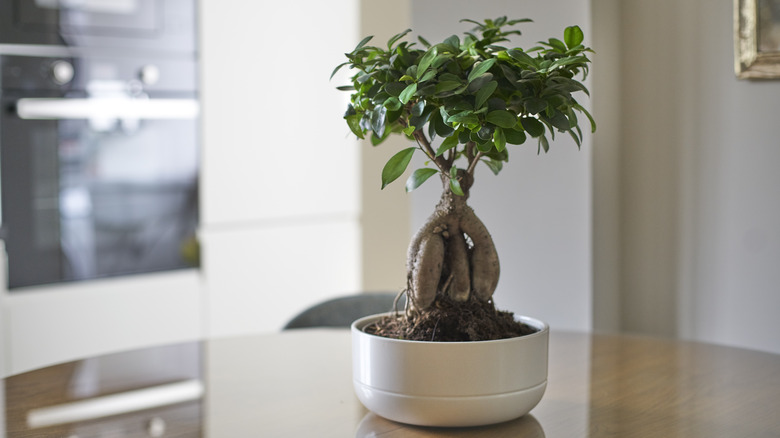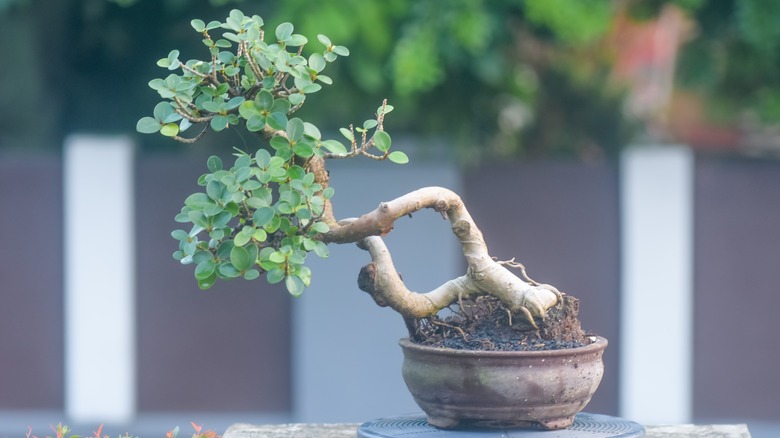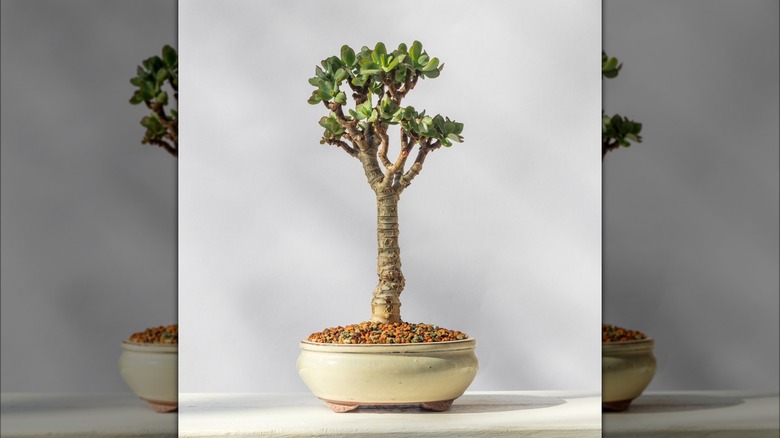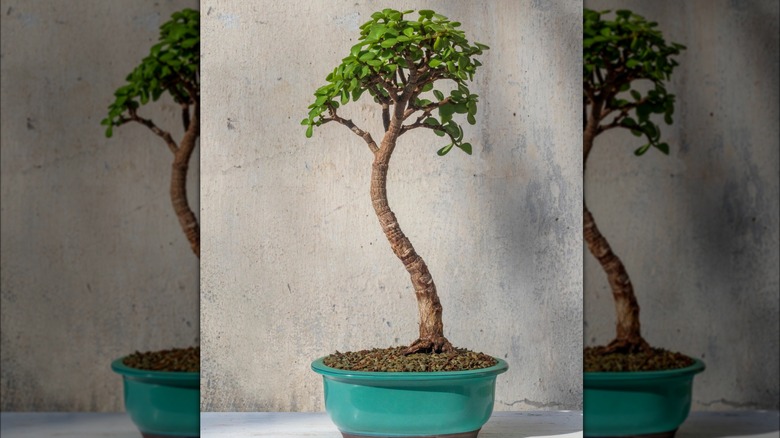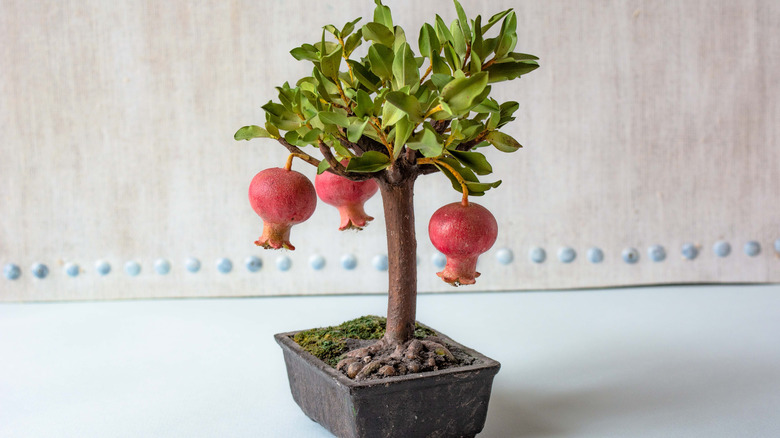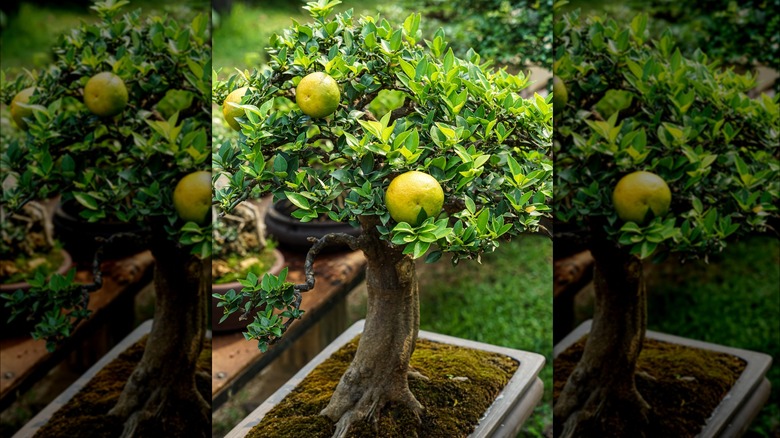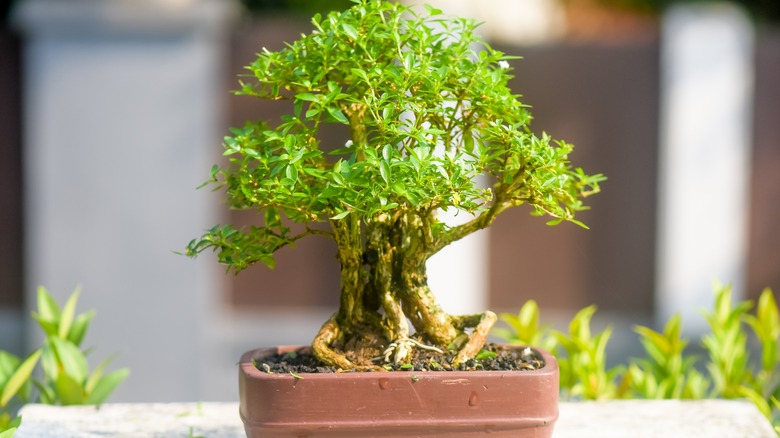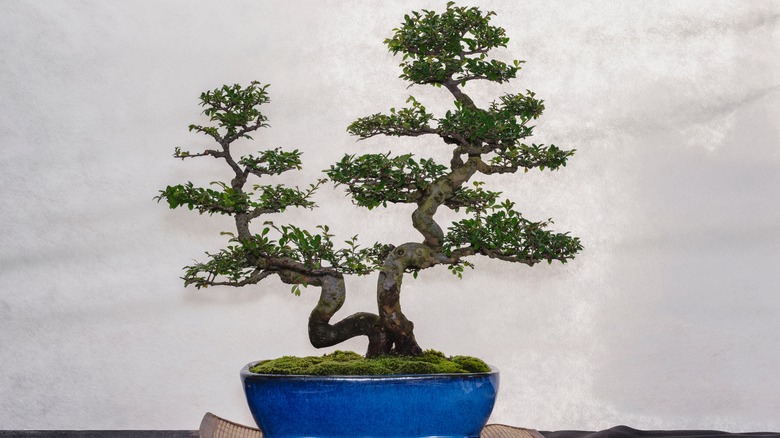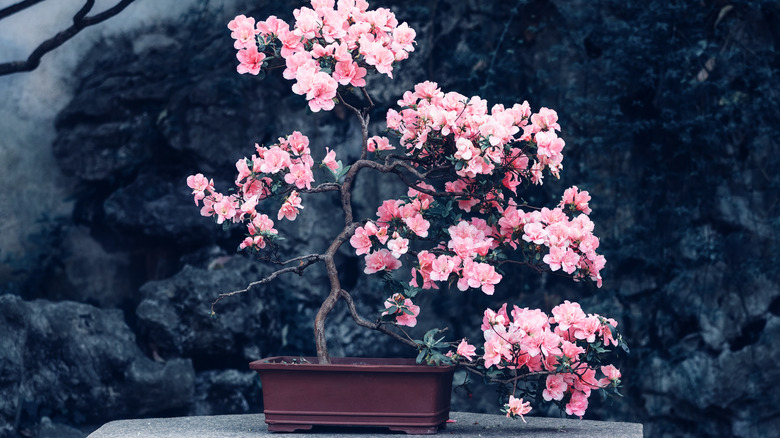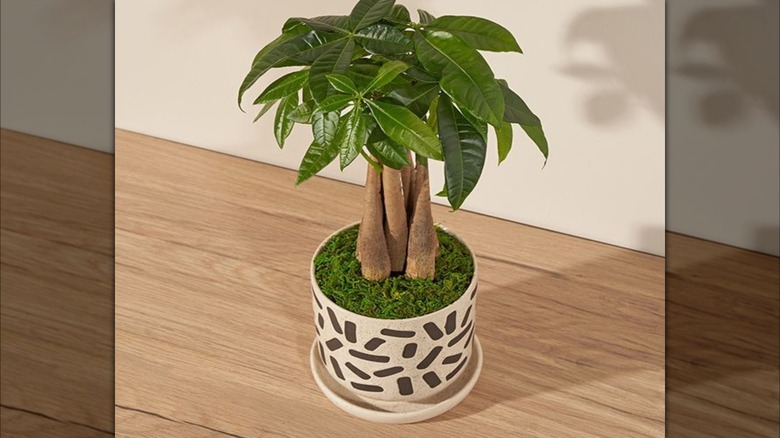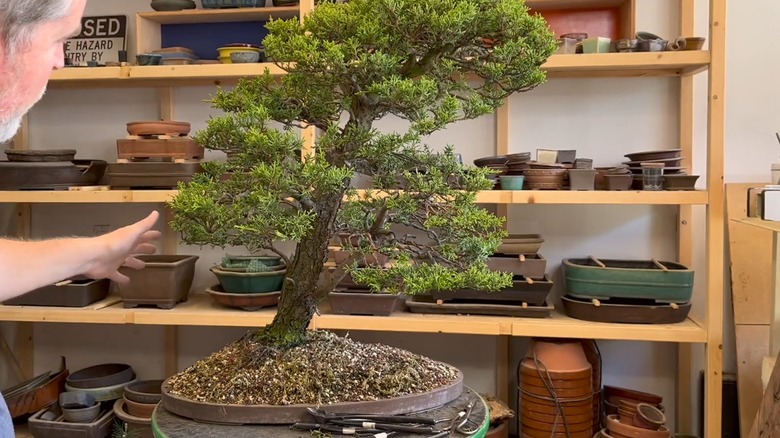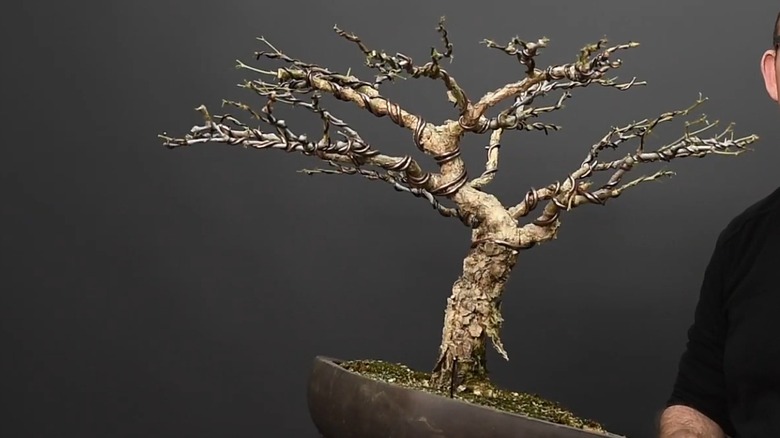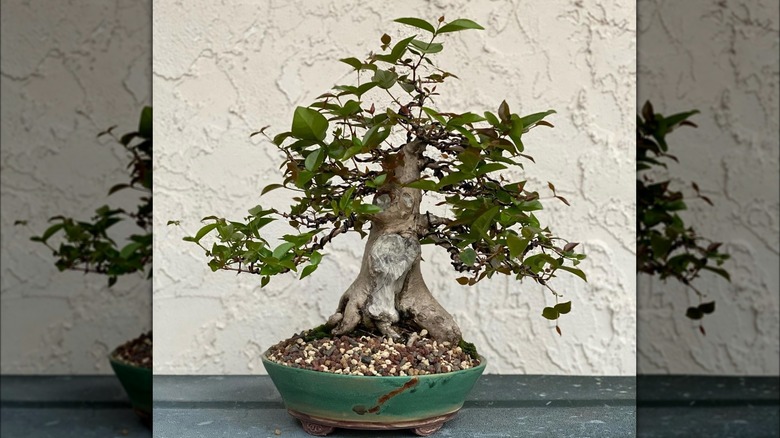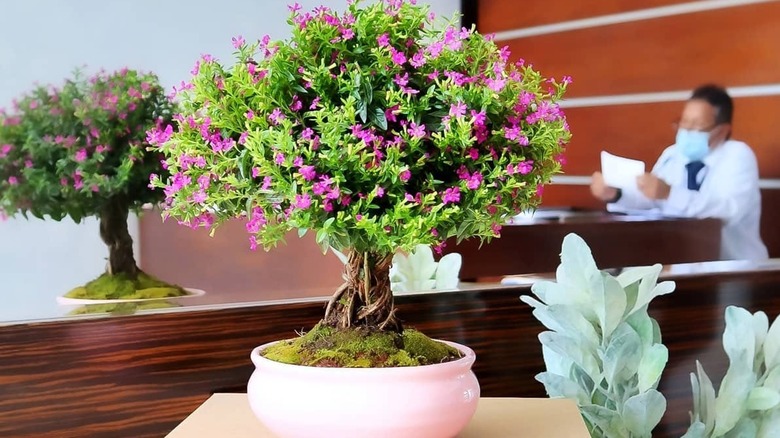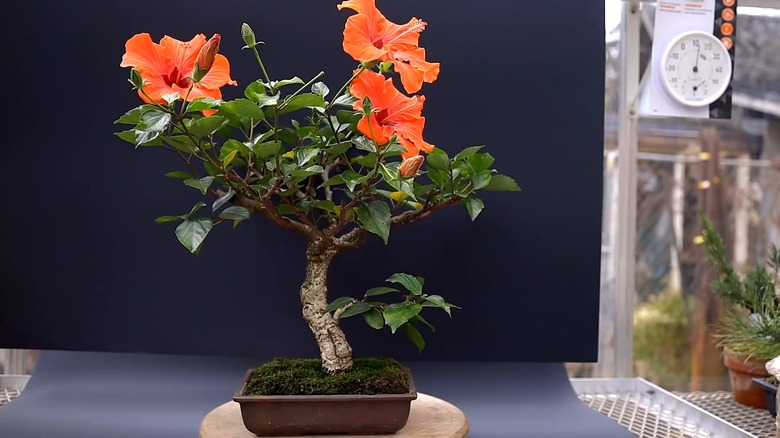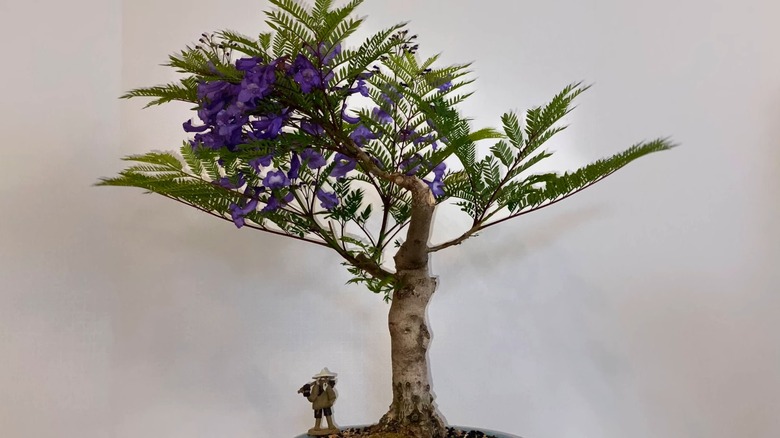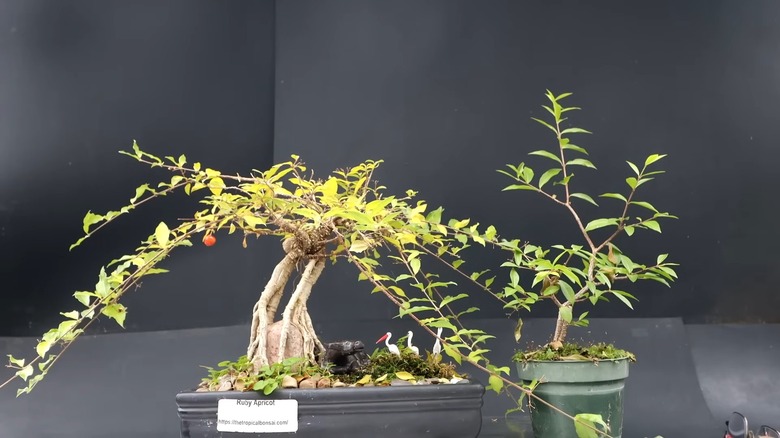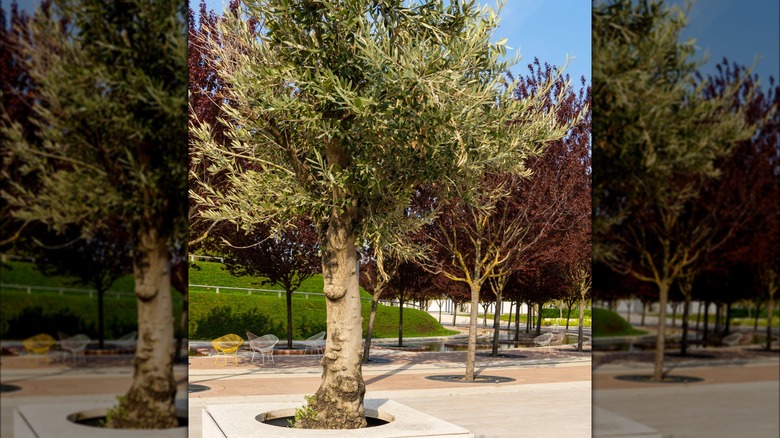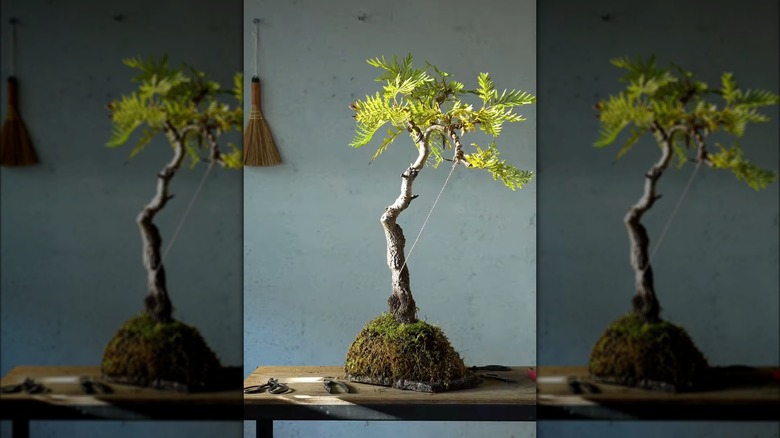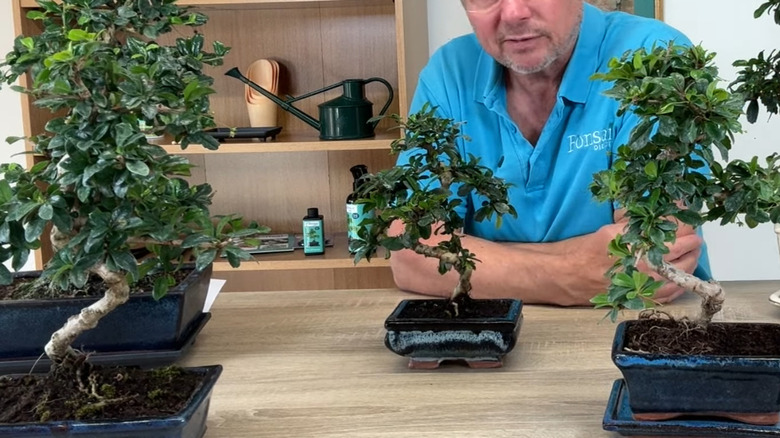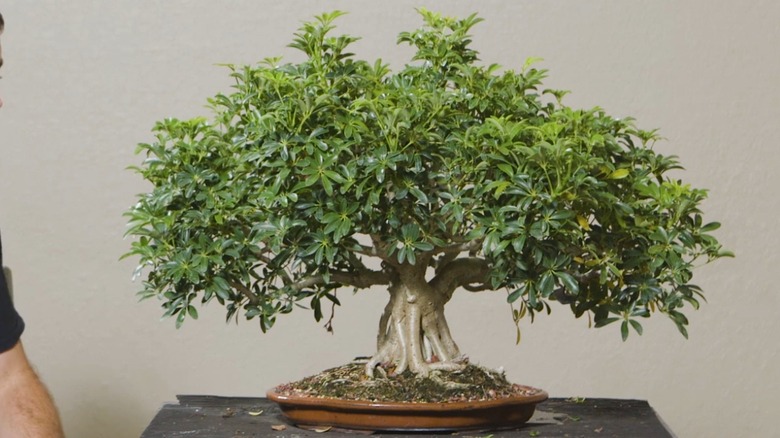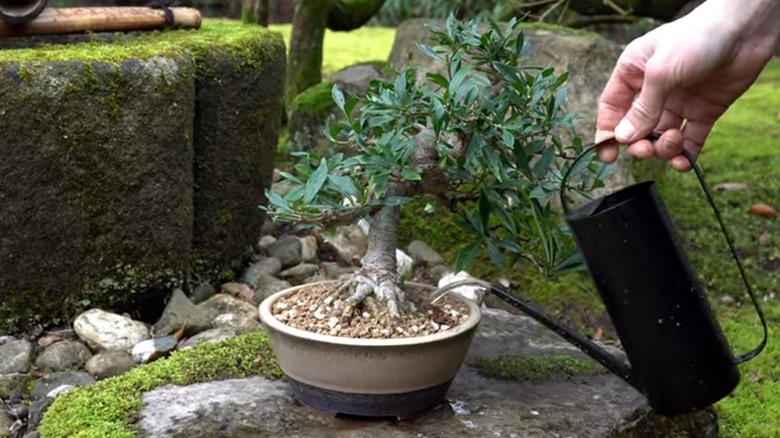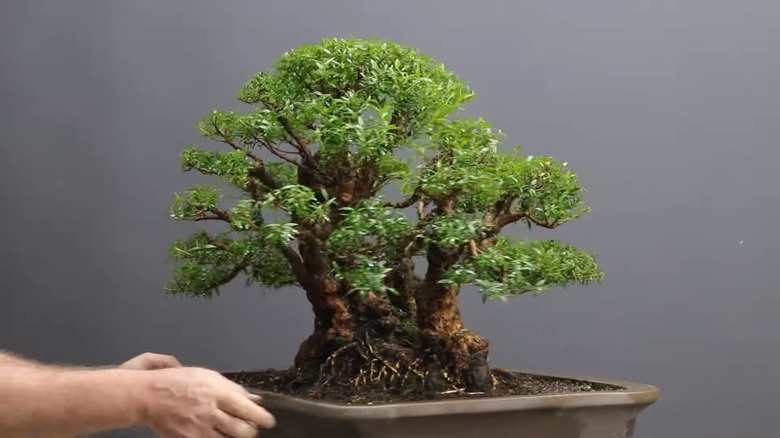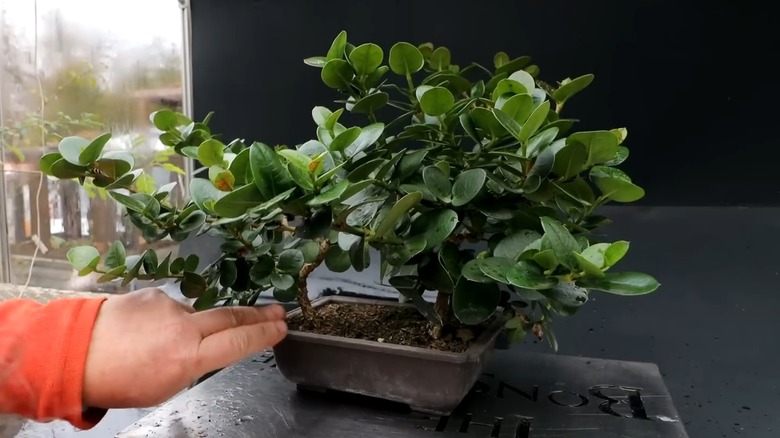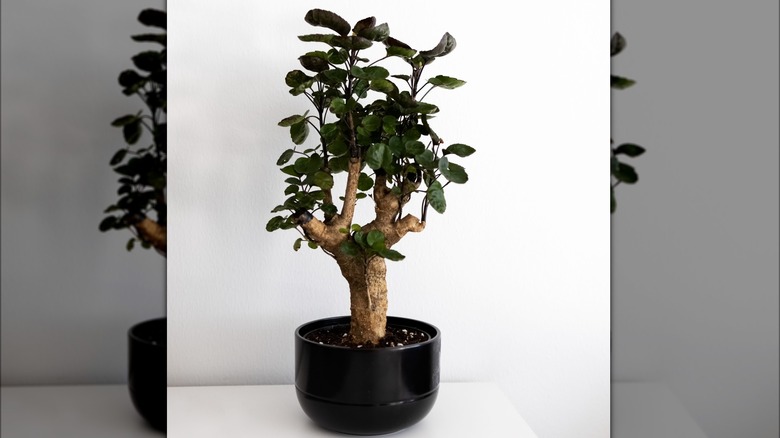24 Types Of Bonsai Trees To Add A Dramatic Flair To Your Indoor Space
A bonsai infuses your indoor space with ageless gravitas, purposive perseverance, and tortured artistry — both yours and the tree's. How could it be that a plant trained to miniaturize its flowers, roots, and branches to fit inside a 15-inch bon (tray) with a mere 10 quarts of soil is expected to appear effortlessly timeless as it would in nature? Sadly, not all tree types render themselves to the art, least of all indoors, even though shallow containers naturally rouse their will to survive for the price of remaining dwarf. In other words, temperate species (such as beech, elm, maple, and more) that prefer the sun, gales, and flurries striking their tiny frames over all seasons are unlikely to survive inside your walls as bonsai do, and are best placed in your backyard.
The types of bonsai trees you should bring to spruce your home are tropical or sub-tropical species (or at least the ones popular as houseplants) like citrus, acacia, cypress, ficus, hibiscus, jade, plum, serissa, pomegranate, and more, as discussed below. Remember, nursery stock will give you the best start, as these are already conditioned to grow in pots. But if you're keen on training your own, look for the more crookedly-branched, tiny plants with healthy roots.
1. Ficus bonsai trees
The easiest bonsai tree for beginners that can live indoors is Chinese banyan 'ginseng' (Ficus microcarpa). It adapts to home temperatures (approximating 68 degrees Fahrenheit) and is quick to sprout its aerial roots (if kept sufficiently humid), lending it the distinct air of eternal beauty. Keeping in bright, indirect light will encourage bigger leaves, though this will set you up for regular pruning (think every couple of months). Since Ficus species isn't drought-tolerant, consistent watering and fertilization are a must. Weeping fig (Ficus benjamina), sacred fig (Ficus religiosa) and mistletoe fig (Ficus diversifolia) are other worthy contenders.
2. Jade plant
Another beginner-friendly bonsai tree option is the jade plant (Crassula ovata), rocking its fleshy, egg-shaped foliage and thick, knotty trunk. As any lazy gardener would attest, forgetting to water their jade weekly doesn't dull its sheen, making your attempt at training a bonsai widely successful. However, don't hold your breath for it to bloom. It also tolerates most soils, from ready-made bonsai mixes (preferable) to ground soils, subject to good drainage and decent lighting. As they're soft-wooded, you'll have to be careful about wiring during training.
3. Elephant bush
Alternatively called dwarf jade, despite no connection to the crassula species except their enigmatic resemblance, elephant bush (Portulacaria afra) gives evergreens a run for bonsai business. Unlike these favorites, it tolerates drying for extended durations (being a succulent helps) and its tiny root ball can easily squeeze itself in a shallow pot without upset. To achieve a venerable look, opt for 'Cork Bark,' a cultivar with highly grooved bark. Ensure you give the baby jade ample light — you'll know you're on the right track when the green leaves grow red. Skip wiring for weekly pinching and pruning.
4. Dwarf pomegranate 'Nana'
Popular for its delectable fruit and ornamental beauty, dwarf pomegranate (Punica granatum 'Nana') can be pruned and shaped into a bonsai tree, but you must be careful of its thorns. Indeed, enthusiasts like to style it into a shohin bonsai (where the plant is kept under 10 inches), half its mature 20 inches length. Although the plant is drought-tolerant, to induce new growth, orangish-red blooms, and the characteristic fruit, you must keep the soil moist during the summer and provide it with decent sun exposure. 'Purple Sunset' and 'Chico' are other laudable dwarf pomegranate cultivars.
5. Citrus species
You can make your mini lemon tree grow like a bonsai for extra space and aesthetics, or like most of the small-leaved, small-fruited citrus varieties, extending to kumquat (Citrus japonica), lime (Citrus aurantiifolia), calamondin (Citrus microcarpa), tangerine (Citrus reticulata), and orange (Citrus sinensis). Although it's ideal to place them outdoors in the summer (they're tropical, after all), keeping them in a warm, well-lit area should do the job. However, you'll need a few grow lights during the winter. Water only when the top 1 inch of soil dries out and prune on the regular to bend them into the desired bonsai style.
6. Snowrose
Since snowrose or tree of a thousand stars (Serissa japonica, previously foetida) grows only 4 feet tall, its tiny frame is easily translated to a bonsai. However, as the sub-tropical plant is quite finicky and given to shedding its leaves at the tiniest environmental change — including when it's brought home from a nursery — it's best left to the more experienced gardeners who don't mind the grind of coaxing the plant back in shape. Though, the spring-through-fall blooming white flowers and gnarled, gray bark make it worth the effort. Keep in a brightly-lit window, mounted on a humidity tray.
7. Chinese elm
Its propensity to display a multitude of cinnamon, olive, and tan shades while its bark peels away has made Chinese or lacebark elm (Ulmus parvifolia) a go-to bonsai tree option for those meaning to add mature character to their indoor space. Plus, it's suitable for novice gardeners, as it readily adapts to most soil and light conditions, is resistant to the much-despised Dutch elm disease, and will pardon watering oversights (generally). If possible, keep it outdoors during the summer; else, pop it in a sunny spot. Since it's a fast grower, prune frequently. Dwarf cultivar 'Seiju' is ideal.
8. Camellia
Camellia, the flowering shrub that Hilary Farr loves, looks just as good as a bonsai if you're talented at wiring and pruning — skills you'll need to work the brittle, woody branches to prevent premature snapping. Their love for partial-to-dappled shade serves them well indoors, provided the spot is well-lit and they are put in acidic soils. However, if you wish to enjoy their classic flowers, but lack a greenhouse, sunroom, or cold frame, you might want to skip these beauties, as they prefer cooler temperatures from fall through winter. Stick to simple-flowered, small-leaved varieties like camellia japonica and camellia sasanqua.
9. Guiana chestnut
Guiana chestnut (Pachira aquatica), or money tree as it's called horticulturally in its stylized bonsai form, is a great, easy-care, 20 inch high, evergreen plant to have indoors. But you must offer it a bright spot (not the window, but close) and make peace with never (okay, rarely) seeing its flowers — the bulbous, furrowed bark (especially if already braided) will more than makeup for it. You'll also need to fertilize it at least twice a year (spring and fall). Prop it over a pebble tray during winter (or whenever it's dry inside) to prevent foliage desiccation.
10. Monterey cypress
Californians may already be familiar with Monterey cypress (Hesperocyparis macrocarpa), a needled beauty flanking their central coast, suffusing the air with a lemony aroma. However, what they might not know is that the scaly-barked tree can be fit in a bonsai pot and trained to miniaturize itself — a task it does with flourish since it's quick to recover and grow from wire wounds. Though this does raise the frequency and intensity of pruning, because otherwise, the bonsai will become top-heavy, destroying the styling. Site in the sunniest window and allow the soil to dry in between waterings.
11. Acacia tree
To bring a touch of tropical Africa or Australia inside your home, consider acacia trees, whose small leaves and mature bark lend perfectly to the open-umbrella bonsai style, known as "Pierneef." Not only are they easy to start with seeds (if you're keen on controlling your bonsai's growth from the get-go), but also simple to wire. Indoors, they may not drop their leaves (despite being deciduous) if the temperatures remain constant, so be prepared to defoliate and cut down their thorns for styling. Cootamundra wattle (Acacia baileyana), tamarindillo (Acacia choriophylla), and Small's acacia (Acacia smallii) are decent options.
12. Surinam cherry
Boasting a stellar multi-stemmed structure, peeling brown bark, and red winter leaves, Surinam cherry (Eugenia uniflora) is another welcome addition to your bonsai collection, barring Florida where it's considered invasive. Place the pot in a south-facing window or supplement with a grow light, as the South American native loves the sun. Apply a slow-release fertilizer every other month, but if you've acquired the taste for the tart cherries, cut its strength by half. Surinam cherry trees have stiff stems, so the easier way to train them is to clip back the growth instead of wiring.
13. Mexican heather
A favorite of hummingbirds and butterflies when decking a patio or a walkway, Mexican heather or Elfin herb (Cuphea hypssopifolia), can steal your heart, too. This gorgeous bonsai blooms lavender, white, or pink flowers atop evergreen foliage. Just ensure to provide it with about four hours of sunlight (not in the midday), water when the topsoil dries out, and minimize all exposure to cold drafts and vents. While you can stick to the tried-and-tested formal and informal bonsai styles, Mexican heather's stems can also be fashioned into tilted and waterfall forms. Repot every other year.
14. Hibiscus trees
You might think hibiscus trees with their enormous flowers and leaves are unlikely to sit well with the bonsai format, but Chinese hibiscus (Hibiscus rosa-sinensis), especially 'Cooperi' cultivar and Rose of Sharon (Hibiscus Syriacum) have got the odds. However, they'll require intense sun exposure, meaning a west- or south-facing sill is the bare minimum. While they'll bloom indoors, it'll be at the cost of nearly stunted, yellowing branch growth, so be prepared to remove the buds if your plant shows such signs of stress. Keeping a moist pebble tray around will make the hibiscus bonsai happy.
15. Jacaranda trees
Although an unusual choice, jacaranda trees (jacaranda mimosifolia) make lovely bonsai specimens, thanks to their fern foliage foiled by spring-blooming, lilac-blue blossoms. However, they entail a lot of work, because of their natural proclivity to produce multiple trunks and weak limbs. That's why you must wire the juvenile branches before they harden for no more than three months at a stretch and ensure they're spaced out proportionally to keep the bonsai tree robust. Jacaranda bonsais require moist, well-draining soils and over four hours of direct sunlight. Fertilize weekly, reducing the frequency to alternate weeks during winter.
16. Miniature holly
Their undulating, glossy foliage may closely match true holly trees, but Miniature holly, or Singapore holly (Malpighia coccigera) aren't related to them. However, that doesn't dim their popularity as bonsai trees, although the pretty, year-round periodic pink flowering, followed by cherry fruits, certainly furthers their charm. True to their tropical nature, miniature holly trees demand good sun exposure (over six hours). Keep the soil moist and fed with a balanced fertilizer during active growth. Style by shearing the stems, and not by wiring. The Texan native Barbados cherry (Malpighia glabra) can be similarly trained into a bonsai specimen.
17. Common olive
For a Mediterranean feel, consider the common olive (Olea europaea), an ornamental fruit tree with textured bark, evergreen silvery-green leaves, and aromatic, white flowers, given to aging beautifully. It requires a lot of sun (especially to bloom beautifully), so a south-facing window is a must. However, poor lighting and low moisture levels in the winter may attract scales, with some preferring to create their indoor greenhouse for olive tree bonsais. Cultivars like 'Skylark Dwarf' and 'Little Ollie' may be easier to work with, or you could switch to the more compact variety, wild olive (Olea europaea sylvestris).
18. Oak trees
If you're the type to pick acorns off the ground on the off chance they germinate and turn into bird-friendly trees, divert a few to creating your bonsai. Remember, they aren't the easiest trees to handle in their bonsai form because of the deep-setting taproot that makes repotting difficult. Moreover, striking the balance in the root-and-shoot pruning process doesn't come easy to novice gardeners, as oaks are disposed to sprouting more growth from their cut wounds. Cork oak (Quercus suber) and silk or silver oak (Grevillea robusta) work best in this format, placed in a bright location.
19. Fukien tea tree bonsai
Marketed as an indoor bonsai by most nurseries, the Fukien tea tree (Ehretia microphylla or Carmona retusa) is sure to add a tropical flair to your space with its glossy foliage and white flowers — if you nail the right conditions. For starters, you'll need to repot the nursery stock in a well-draining soil mix, as in the trade they're rooted in clay substrates, and keep it moist. Place the bonsai where it receives morning sun and possibly outdoors during the growth season. Allow the plant to grow for a while before pruning it to your chosen bonsai style.
20. Dwarf umbrella tree
Traditionalists might scoff at the idea of turning the dwarf or Hawaiian umbrella tree (Heptapleurum arboricola, formerly Schefflera) into a bonsai, but it works and well at that, especially indoors when light is premium — flowers may be a rare occurrence, though. Ideally, they prefer around three hours of filtered light exposure on an east or west-facing window, and water whenever the soil dries out (or leaves begin to drop). Humidity trays will improve their growth. Winter defoliation may be necessary if pests pose a problem. Umbrella bonsai may require a base to keep it stable during repotting.
21. Star jasmine
Popular as a sprawling vine for a lattice, fence, or the ground, star jasmine or confederate star (Trachelospermum jasminoides) can switch its role and become a flowering bonsai tree. For success, ensure it gets plenty of sun — south-facing windows are a plus — and water, since it dislikes dry soils. Additionally, mount the tropical plant over a humidity tray and fertilize every month for plant vigor. Regular stem shearing will redirect the plant's energy into producing a thicker bark. Remember to replant star jasmine bonsai every four years. Close associates like Parker Jasmine (Chrysojasminum parkeri) are also great indoors.
22. Common myrtle
Common myrtle (Myrtus communis) is the evergreen plant to-go if you want an easy-maintenance bonsai tree that also doubles as an herb and edible fruit-bearer. Although it tolerates semi-shade, this puts it at risk of attracting the attention of whiteflies and spider mites. That's why it's best to site your myrtle tree in a sunny window or expose it to grow lights to keep pests at bay. Common myrtles dislike lime, so ensure their soil mix is slightly acidic and that — whenever possible — they're soaked in rainwater (time to put some rain barrels out).
23. Natal plum
Quite popular as a tropical hedge and security screen, thanks to its spiny foliage, the natal plum (Carissa macrocarpa, previously grandiflora) can be sheared into a bonsai tree and enjoyed for its wrinkled stems, starry fragrance (in bloom), and palatable fruit. Any spot that provides six hours of direct access to sunlight works for the plum tree bonsai, but ensure it isn't left thirsting for water. In humid winters, fan the plant to deter fungal spores. Natal plum is best styled into cascade or informal forms, preferably via pruning, although wiring will work for young shoots.
24. Aralia
Popular aralia houseplants, such as Geranium aralia (Polyscias guilfoylei), Ming aralia (Polyscias fruticosa), and fern-leaf aralia (Polyscias filicifolia) can be shaped into bonsai trees if you aren't hung up on their white flowers. They're especially a good match if your home has limited or filtered sun exposure, as they'll be happy as a bean even in north-facing windows. Regular misting and moist soils are non-negotiables for the tropical species. Considering their soft bark, it's better to steer clear of wiring and, instead, focus on pruning the plant as it grows out into broom style or formal upright designs.
